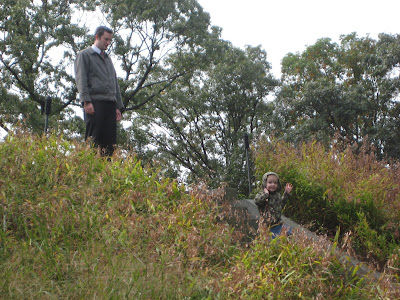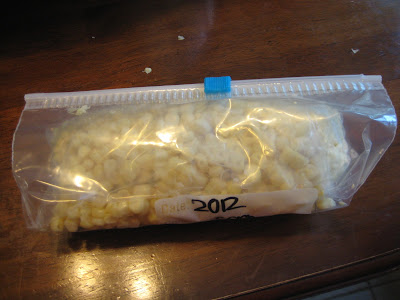We got kind of a late start on corn this year. In the old days we always got it done during the summer. Lately it has been happening later and later. This year it didn't get done until Sept. 17th. The kids had the day off from school so they were "happy" to help. We decided to take photos along the way so that if anyone down the road wanted to see the steps we take when freezing our corn, they would have a nice little picture tutorial to walk them through. Here we go!!
First we bought our bags of corn. Usually we just go to the local stand and get 100 -200 ears depending on how much we need. This year, one of Steve's employees had corn to sell from his farm so we bought 100 ears from him. He even delivered it to our home...pretty sweet!!!
Although small ears often have very tender corn, large ears will give you a better yield and usually have more developed kernels for freezing. You don't want old corn but you do want big ears.
Prices will depend on the year. I can usually get it for $12 - $15 dollars per crate (50 ears) so it costs me $30 dollars for 100 ears. If you have a big family, you will want to do more. The only other costs are the bags and the ice. A small price to pay for delicious corn all year round!!
Next, we set up this little make-shift husking/scrubbing stand outside so that the mess of cleaning the corn does not come into the house. There have been a couple of years when it rained and we did this either in the garage or laundry room, but outside works best.
You get a couple of people husking (check out the determination in Evan's face)....
....and then they put the husked ears in a big container of water that we fill with the hose and put up on a couple of our picnic benches.
Then I come and scrub the corn so that most of the silk is removed before putting it in a pan to take into the house for further processing. I just use a vegetable brush and gently scrub each ear.
We just throw our husks in a wheel barrow and then go dump them in the woods. The husks break down just like any other leaf. If you don't live in the woods, you would just bag these and put them out with the trash.
Make sure that "the help" finishes the outside part of the process by returning all the necessary equipment to where it goes. What a tough guy!!
Once the corn is husked and scrubbed, bring it inside and place it on a folded towel on the counter. I like to totally clear everything off my counters before doing corn so that I can make sure all surfaces are clean before and after the process. Make sure to clean out and sanitize your sink beforehand.
Next, I load the corn into a bowl which is similar in size to the pan I will be using to cook the corn.
Bring a half full stock pot of water to a rolling boil.
Then load the corn in one by one, standing each cob on its end if possible
Blanch, or boil, the corn for about 3 minutes. Then carefully remove the ears using tongs to a pan to be carried to the sink. I use the same metal 9x13 pan that I carry the ears in from the outside station to the counter.
While the cooking part is happening, there is plenty for the helpers to do.
Make sure to label each bag with a name and date.
I like to start with a new box of freezer bags. That way I don't have to count them as I am bagging them. At the end of the process, if the bags are gone...I know I froze 40 bags worth.
Make sure that you buy (or freeze yourself) plenty of ice beforehand. It is important to keep the water in the sink ice cold for the cooling part of the process. I bought two large bags of ice and also used some from my freezer to do the 100 ears.
Fill the sink with water and ice and then put the cooked corn immediately into the cold water bath for at least the same amount of time it cooked....so about 3 minutes.
Make sure to continually add ice to the sink so that the corn properly cools.
Then stack the corn on a folded towel to the side of the sink.
Now it is time to cut and bag. I like to set up the cutting station so that everything is ready. This is the messiest part inside the house. Rather than a cutting board, I use a tray with sides on it. This prevents corn from going all over. I cookie sheet would also work. Don't forget the garbage can for those cobs. Your helper can keep the pan on the table full by restocking from the counter.
Stand the ear on the flat side and cut off the corn in rows.
Don't worry about breaking the corn apart. It will separate as it is bagged and flattened. Remove and discard any silk that you might see at this point.
Scrape the tray into a big bowl and repeat.
Cobs should be thrown in the trash. Don't over fill, though. They are heavy and will break the garbage bag if it gets too full. (As you can see from this photo....hydration if very important for your helpers. :)
Use quart size freezer bags and fill them according to your own specifications. I used to put about 3 cups in a bag when my family was larger, but now I use a 3/4 cup and fill it three times instead. Be especially careful to fill the bags over the bowl so that corn doesn't go everywhere.
After filling the bag, remove all air from the bag by rolling it up tight and then sealing it.
Then flatten the bag out for easy stacking. This allows for more even thawing when the bag is removed from the freezer for eating, too.
I have a big chest freezer so to keep things in their place, I use baskets or boxes. I just stack the bags of corn in the box and then place the whole box in the freezer. Do whatever works for you.
It might seem like a lot of work, but it only takes a morning to do about 100 ears, and then we have enough corn to last us through the year. I use most of it for Sunday dinners, so if you figure 52 weeks in a year and take out the weeks when you are eating fresh corn on the cob...you're good.
HAPPY FREEZING!!!!!



































































